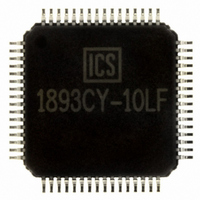ICS1893Y-10LF IDT, Integrated Device Technology Inc, ICS1893Y-10LF Datasheet - Page 49

ICS1893Y-10LF
Manufacturer Part Number
ICS1893Y-10LF
Description
PHYCEIVER LOW PWR 3.3V 64-TQFP
Manufacturer
IDT, Integrated Device Technology Inc
Series
PHYceiver™r
Type
PHY Transceiverr
Specifications of ICS1893Y-10LF
Protocol
MII
Voltage - Supply
3.14 V ~ 3.47 V
Mounting Type
Surface Mount
Package / Case
64-TQFP, 64-VQFP
Lead Free Status / RoHS Status
Lead free / RoHS Compliant
Number Of Drivers/receivers
-
Other names
1893Y-10LF
800-1935-5
ICS1893Y-10LF
800-1935-5
ICS1893Y-10LF
Available stocks
Company
Part Number
Manufacturer
Quantity
Price
Company:
Part Number:
ICS1893Y-10LF
Manufacturer:
ICS
Quantity:
5 978
Company:
Part Number:
ICS1893Y-10LF
Manufacturer:
IDT, Integrated Device Technology Inc
Quantity:
10 000
Company:
Part Number:
ICS1893Y-10LFT
Manufacturer:
IDT, Integrated Device Technology Inc
Quantity:
10 000
6.3.5 PCS Control Signal Generation
6.3.6 4B/5B Encoding/Decoding
ICS1893Y-10 Rev F 1/20/04
For the PCS sublayer, there are two control signals: a Carrier Sense signal (CRS) and a Collision Detect
signal (COL).
The CRS control signals is generated as follows:
1. When a logic zero is detected in an idle bit stream, the Receive Functions examines the ensuing bits.
2. When the Receive Functions find the first two non-contiguous zero bits, the Receive state machine
3. As a result, the Boolean Receiving variable is set to TRUE.
4. Consequently, the Carrier Sense state machine moves into the Carrier Sense ‘on’ state, which asserts
5. If the PCS Functions:
The COL control signal is generated by the transmit modules. For details, see
Transmit
The 4B/5B encoding methodology maps each 4-bit nibble to a 5-bit symbol (also called a “code group”).
There are 32 five-bit symbols, which include the following:
•
•
Note:
Of the 32 five-bit symbols, 16 five-bit symbols are required to represent the 4-bit nibbles.
The remaining 16 five-bit symbols are available for control functions. The IEEE Standard defines 6
symbols for control, and the remaining 10 symbols of this grouping are invalid. The 6 control symbols
include the following:
If the ICS1893Y-10 PCS receives:
– /H/, which represents a Halt, also used to signify a Transmit Error
– /I/, which represents an IDLE
– /J/, which represents the first symbol of the Start-of-Stream Delimiter (SSD)
– /K/, which represents the second symbol of the Start-of-Stream Delimiter (SSD)
– /T/, which represents the first symbol of the End-of-Stream Delimiter (ESD)
– /R/, which represents the second symbol of the End-of-Stream Delimiter (ESD)
– One of the 10 undefined symbols, it sets its QuickPoll Detailed Status Register’s Invalid Symbol bit
– A Halt symbol, it sets the Halt Symbol Detected bit in its QuickPoll Detailed Status Register (bit 17.6)
ICS1893Y-10 - Release
moves into the Carrier Detect state.
the CRS signal.
a. Cannot confirm either the /I/J/ (IDLE, J) symbols or the /J/K/ symbols, the receive error signal
b. Can confirm the /I/J/K/ symbols, then the Receive state machine transitions to the ‘Receive’ state.
(bit 17.7) to logic one.
to logic one.
(RX_ER) is asserted, and the Receive state machine returns to the IDLE state. In IDLE, the
Boolean Receiving variable is set to FALSE, thereby causing the Carrier Sense state machine to
set the CRS signal to FALSE.
An STA can force the ICS1893Y-10 to transmit symbols that are typically classified as invalid, by
both (1) setting the Extended Control Register’s Transmit Invalid Codes bit (bit 16.2) to logic one
and (2) asserting the associated TXER signal. For more information, see
Error Code Test (bit
Module”.
16.2)”.
Copyright © 2004, Integrated Circuit Systems, Inc.
All rights reserved.
49
Section 6.3.3.1, “PCS
Chapter 6 Functional Blocks
Section 7.11.7, “Invalid
January, 2004
















